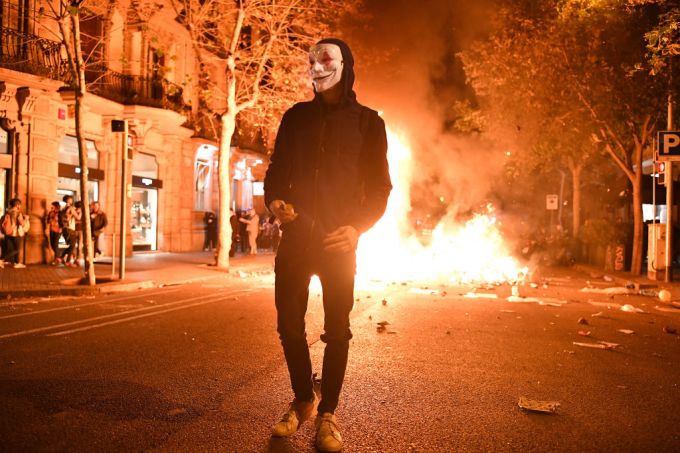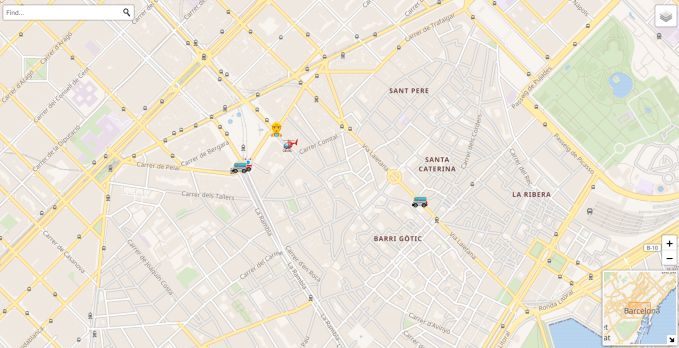Is our age of ubiquitous smartphones and social media turning into an era of mass civil unrest? Two years after holding an independence referendum and unilaterally declaring independence in defiance of the Spanish state — then failing to gain recognition for la república and being forced to watch political leaders jailed or exiled — Catalonia’s secessionist movement has resurfaced with a major splash.
One of the first protest actions programmed by a new online activist group, calling itself Tsunami Democràtic, saw thousands of protestors coalescing on Barcelona airport Monday, in an attempt to shut it down. The protest didn’t quite do that but it did lead to major disruption, with roads blocked by human traffic as protestors walked down the highway and the cancelation of more than 100 flights, plus hours of delays for travellers arriving into El Prat.
For months leading up to a major Supreme Court verdict on the fate of imprisoned Catalan political leaders a ‘technical elite‘ — as one local political science academic described them this week — has been preparing to reboot Catalonia’s independence movement by developing bespoke, decentralized high-tech protest tools.
A source with knowledge of Tsunami Democràtic, speaking to TechCrunch on condition of anonymity, told us that “high level developers” located all around the world are involved in the effort, divvying up coding tasks as per any large scale IT project and leveraging open source resources (such as the RetroShare node-based networking platform) to channel grassroots support for independence into a resilient campaign network that can’t be stopped by the arrest of a few leaders.
Demonstrators at the airport on Monday were responding directly to a call to blockade the main terminal posted to the group’s Telegram channel.
Additional waves of protest are being planned and programmed via a bespoke Tsunami Democràtic app that was also released this week for Android smartphones — as a sideload, not yet a Google Play download.
The app is intended to supplement mainstream social network platform broadcasts by mobilizing smaller, localized groups of supporters to carry out peaceful acts of civil disobedience all over Catalonia.
Our source walked us through the app, which requires location permission to function in order that administrators can map available human resources to co-ordinate protests. We’re told a user’s precise location is not shared but rather that an obfuscated, more fuzzy location marker gets sent. However the app’s source code has not yet been open sourced so users have to take such claims on trust (open sourcing is said to be the plan — but only once the app has been scrubbed of any identifying traces, per the source).
The app requires a QR code to be activated. This is a security measure intended to manage activation in stages, via trusted circles of acquaintances, to limit the risk of infiltration by state authorities. Though it feels a bit like a viral gamification tactic to encourage people to spread the word and generate publicity organically by asking their friends if they have a code or not.

Whatever it’s really for the chatter seems to be working. During our meeting over coffee we overheard a group of people sitting at another table talking about the app. And at the time of writing Tsunami Democràtic has announced 15,000 successful QR code activations so far. Though it’s not clear how successful the intended flashmob civil disobedience game-plan will be at this nascent stage.
Once activated, app users are asked to specify their availability (i.e. days and times of day) for carrying out civil disobedience actions. And to specify if they own certain mobility resources which could be utilized as part of a protest (e.g. car, scooter, bike, tractor).
Examples of potential actions described to us by our source were go-slows to bring traffic grinding to a halt and faux shopping sprees targeting supermarkets where activists could spend a few hours piling carts high with goods before leaving them abandoned in the store for someone else to clean up.
One actual early action carried out by activists from the group last month targeted a branch of the local CaixaBank with a masked protestor sit-in.
Our source said the intention is to include a pop-up in the app as a sort of contract of conscience which asks users to confirm participation in the organized chaos will be entirely peaceful. Here’s an example of what the comprometo looks like:

Users are also asked to confirm both their intention to participate in a forthcoming action (meaning the app will capture attendance numbers for protests ahead of time) and to check in when they get there so its administrators can track actual participation in real-time.
The app doesn’t ask for any personal data during onboarding — there’s no account creation etc — although users are agreeing to their location being pervasively tracked.
And it’s at least possible that other personal data could be passed via, for example, a comment submission field that lets people send feedback on actions. Or if the app ends up recording other data via access to smartphone sensors.
The other key point is that users only see actions related to their stated availability and tracked location. So, from a protestor’s point of view, they see only a tiny piece of the Tsunami Democràtic protest program. The user view is decentralized and information is distributed strictly piecemeal, on a need to know basis.
Behind the scenes — where unknown administrators are accessing its data and devising and managing protest actions to distribute via the app — there may be an entirely centralized view of available human protest resources. But it’s not clear what the other side of the platform looks like. Our source was unable to show it to us or articulate what it looks like.
Certainly, administrators are in a position to cancel planned actions if, for example, there’s not enough participation — meaning they can invisibly manage external optics around engagement with the cause. Not enough foot soldiers for a planned protest? Just call it off quietly via the app.
Also not at all clear: Who the driving forces are behind the Tsunami Democràtic protest mask?
“There is no thinking brain, there are many brains,” a spokesman for the movement told the El Diario newspaper this week. But that does raise pretty major questions about democratic legitimacy. Because, well, if you’re claiming to be fighting for democracy by mobilizing popular support, and you’re doing it from inside a Western democracy, can you really claim that while your organization remains in the shadows?
Even if your aim is non-violent political protest, and your hierarchy is genuinely decentralized, which is the suggestive claim here, unless you’re offering transparency of structure so as to make your movement’s composition and administration visible to outside scrutiny (so that your claims of democratic legitimacy can be independently verified) then individual protestors (the app’s end users) just have to take your word for it.
End users who are being crowdsourced and coopted to act out via app instruction as if they’re pawns on a high tech chess board. They are also being asked (implicitly) to shoulder direct personal risk in order that a faceless movement generates bottom up political pressure.
So there’s a troubling contradiction here for a movement that has chosen to include the word ‘democractic’ in its name. (The brand is a reference to a phase used by jailed Catalan cultural leader, Jordi Cuixart.) Who or what is powering this wave?

We also now know all too well how the double-sided nature of platforms means these fast-flowing technosocial channels can easily be misappropriated by motivated interest groups to gamify and manipulate opinion (and even action) en masse. This has been made amply clear in recent years with political disinformation campaigns mushrooming into view all over the online place.
So while emoji-strewn political protest messages calling for people to mobilize at a particular street corner might seem a bit of harmless ‘Pokemon Go’-style urban fun, the upshot can — and this week has — been far less predictable and riskier than its gamified packaging might suggest.
Plenty of protests have gone off peacefully, certainly. Others — often those going on after dusk and late into the night — have devolved into ugly scenes and destructive clashes.
There is clearly a huge challenge for decentralized movements (and indeed technologies) when it comes to creating legitimate governance structures that don’t simply repeat the hierarchies of the existing (centralized) authorities and systems they’re seeking to challenge.
The anarchy-loving crypto community’s inability to coalesce around a way to progress with blockchain technology looks like its own self-defeating irony. A faceless movement fighting for ‘democracy’ from behind an app mask that allows its elite string-pullers and data crunchers to remain out of sight risks looking like another.
None of the protestors we’ve spoken to could say for sure who’s behind Tsunami Democràtic. One suggested it’s just “citizens” or else the same people who helped organize the 2017 Catalan independence referendum — managing the movement of ballot papers into and out of an unofficial network of polling stations so that votes could be collected and counted despite Spanish authorities’ best efforts to seize and destroy them.
There was also a sophisticated technology support effort at the time to support the vote and ensure information about polling stations remained available in the face of website takedowns by the Spanish state.
Our source was equally vague when asked who is behind the Tsunami Democràtic app. Which, if the decentralizing philosophy does indeed run right through the network — as a resilience strategy to protect its members from being ratted out to the police — is what you’d expected.
Any single node wouldn’t know or want to know much of other nodes. But that just leaves a vacuum at the core of the thing which looks alien to democratic enquiry.
One thing Tsunami Democràtic has been at pains to make plain in all (visible) communications to its supporters is that protests must be peaceful. But, again, while technology tools are great enablers it’s not always clear exactly what fire you’re lighting once momentum is pooled and channeled. And protests which started peacefully this week have devolved into running battles with police with missiles being thrown, fires lit and rubber bullets fired.
Some reports have suggested overly aggressive police response to crowds gathering has triggered and flipped otherwise calm protestors. What’s certain is there are injuries on both sides. Today almost 100 people were reported to have been hurt across three nights of protest action. A general strike and the biggest manifestation yet is planned for Friday in Barcelona. So the city is braced for more trouble as smartphone screens blink with fresh protest instructions.

Social media is of course a conduit for very many things. At its most corporate and anodyne its stated mission can be expressed flavorlessly — as with Facebook’s claimed purpose of ‘connecting people’. (Though distracting and/or outraging is often closer to the mark.)
In practice, thanks to human nature — so that means political agendas, financial interests and all the rest of our various and frequently conflicting desires — all sorts of sparks can fly. None more visibly than during mass mobilizations where groups with a shared agenda rapidly come together to amplify a cause and agitate for change.
Even movements that start with the best intentions — and put their organizers and administration right out in the open for all to see and query — can lose control of outcomes.
Not least because malicious outsiders often seize the opportunity to blend in and act out, using the cover of an organized protest to create a violent disturbance. (And there have been some reports filtering across Catalan social media claiming right wing thugs have been causing trouble and that secret police are intentionally stirring things up to smear the movement.)

BARCELONA, SPAIN – OCTOBER 17: Protesters take to the streets to demonstrate after the Spanish Supreme Court sentenced nine Catalan separatist leaders to between 9 and 13 years in prison for their role of the 2017 failed Catalan referendum on October 17, 2019 in Barcelona, Spain. (Photo by Jeff J Mitchell/Getty Images)
So if a highly charged political campaign is being masterminded and micromanaged remotely, by unknown entities shielded behind screens, there are many more questions we need to be asking about where the balance of risk and power lies, as well as whether a badge of ‘pro-democracy’ can really be justified.
For Tsunami Democràtic and Catalonia’s independence movement generally this week’s protests look to be just the start of a dug-in, tech-fuelled guerrilla campaign of civil disobedience — to try to force a change of political weather. Spain also has yet another general election looming so the timing offers the whiff of opportunity.
The El Prat blockade that kicked off the latest round of Catalan unrest seemed intended to be a flashy opening drama. To mirror and reference the pro-democracy movement in Hong Kong — which made the international airport there a focal point for its own protests, occupying the terminal building and disrupting flights in an attempt to draw the world’s attention to their plight.
In a further parallel with protests in Hong Kong a crowdsourced map similar to HKmaps.live — the app that dynamically maps street closures and police presence by overlaying emoji onto a city view — is also being prepared for Catalonia by those involved in the pro-independence movement.
At the time of writing a handful of emoji helicopters, road blocks and vans are visible on a map of Barcelona. Tapping on an emoji brings up dated details such as what a police van was doing and whether it had a camera. A verified status suggests multiple reports will be required before an icon is displayed. We understand people will be able to report street activity for live-mapping via a Telegram bot.

Screenshot of Catalan live map for crowdsourcing street intel
Our source suggested police presence on the map might be depicted by chick emojis. Aka Piolín: The Spanish name for the Loony Tunes cartoon character Tweety Pie — a reference to a colorfully decorated cruise ship used to house scores of Spanish national police in Barcelona harbor during the 2017 referendum, providing instant meme material. Though the test version we’ve seen seems to be using a mixture of dogs and chicks.
Along with the Tsunami Democràtic app the live map means there will soon be two bespoke tools supporting a campaign of civil disobedience whose unknown
source https://techcrunch.com/2019/10/17/catalan-separatists-have-tooled-up-with-a-decentralized-app-for-civil-disobedience/
No comments:
Post a Comment